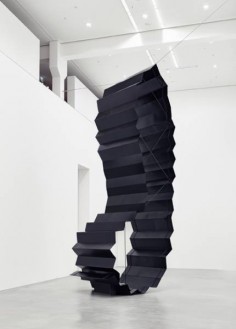KATJA STRUNZ
source: recentfuturearchive
Katja Strunz has created a spatial composition entitled Drehmoment (Viel Zeit, wenig Raum) (Torque [Much Time, Little Space]), dominated by two monumental metal objects. With this work, she continues her exploration of folding and collapsing time and space and transfers it to the museum’s entrance hall.
The exhibition title also evokes the association of machine parts. Drehmoment (Torque) refers to the force that sets a vehicle in motion. In this context, the black ribbon seems like the drive belt of a motor, which when torn brings movement to a standstill.
The first part of the work consists of an irregularly folded structure of sheet metal that occupies the front part of the exhibition space
The remaining half of the space is dominated by a monumental black metal ribbon that is held up by a steel rope at a height of 8 meters, its loose end lying on the floor. In contrast to the first work, the shape here is defined by regular folds that, like a stairwell, are pressed together towards the top. The beginning and end of the ribbon are placed in such a way so as to give the impression of a closed circle.
Another part of the exhibition shows a selection of four sheets from the series Yesterday’s Papers, which Katja Strunz has been working on since 2001. The series consists of loose sheets from historical publications that Katja Strunz has reprinted using classical printing techniques. From the present, she uses historical means to intervene in a sphere of the past, redefining it according to her own rules. The letters and symbols used thus fall into the space of history, making the historical distance between past and present visible.
With this year’s Vattenfall Contemporary, the jury honors an artist whose work reveals a confident approach to space, as can be seen in her various exhibitions and here once again in her show at Berlinische Galerie.
Vattenfall Contemporary includes a solo show at Berlinische Galerie, the publication of an exhibition
catalogue, and a purchase for the Vattenfall Collection.
.
.
.
.
.
.
.
.
source: alminerech
The works of Katja Strunz bear the traces of lived experience, of a past that manifests itself through the use of recycled materials. In some of her pieces she combines these old elements with new designed, industrial or handmade elements. She calls this group of works “constructed fragments”. Fed by her own archaeology of modernity, her work constructs itself in the present, by proposing a temporality in which future, present and past draw heavily on one another.
When displaying her works for an exhibition, nothing is left to chance: by establishing slight nuances of times and spaces, Strunz’s sculptures interact and seem to capture a moment. A moment taken from an endless progression of a movement, maybe from the ticking of a clock, as the title of the exhibition “Tick-Tock, Crick-Clock” indicates.
The core of the show is a large-scale, handmade wooden clock leaning against the walls of the gallery. Stripped of its primary function, that of indicating the passing of time, the wooden clock leaves no room for doubt: it represents a moment that is frozen in time. All the other sculptures shown in the exhibition look like broken parts, like fallen or folded fragments of this clock- for example the long chain, that hangs from the ceiling. It is made from diverse metal circles and could be the bust mechanism of the ticker.
The sculptures seem to respond to the laws of gravity: they are in a state of free fall, but seem to have been captured just as they were about to collapse to the floor. The folds in the sculptures underline the idea of an interruption in the time-space by identifying the moment of change, like a sign of the ageing process. The fall and the fold are both typical elements of Katja Strunz` work and closely linked to the fact, that material is subject to temporal decay.
Born in 1970 in Ottweiler, Germany, Katja Strunz lives and works in Berlin.
.
.
.
.
.
.
.
source: artspycn
施特龙茨的作品遵循了有生命的体验的轨迹、遵循了过去通过回收利用的材料来表现自己的轨迹。在她的某些作品中,她将那些老旧的元素与新设计的工业或是人工制作的元素融合到一起。她将这样的作品称为“构造的碎片”。依靠她自己对现代性考古研究持,她的作品通过提出一种暂时性——在这种暂时性中,未来、现在和过去都互相产生了较为重大的影响——而在现在建立起了自身。Walter Benjamin评论施特龙茨的作品说:“它们的起源存在于形成的过程中。”从这一点上看,这位艺术家的作品则是在已经过去了的事物中寻找现在。


